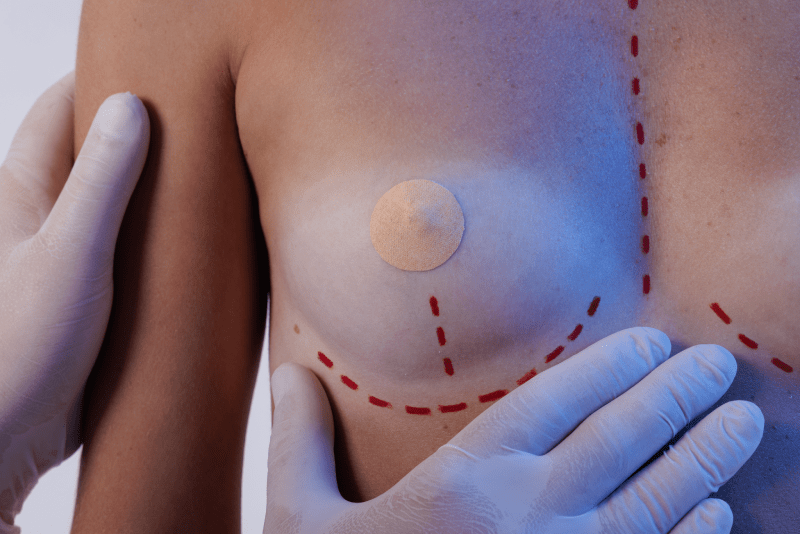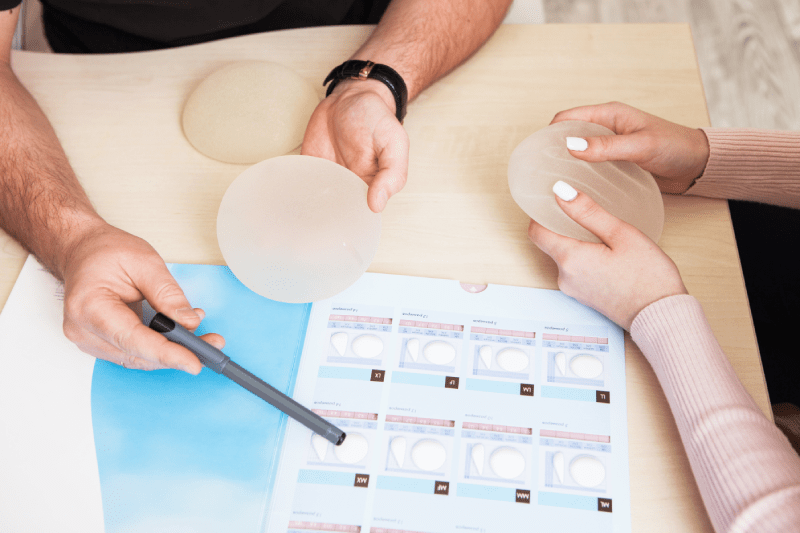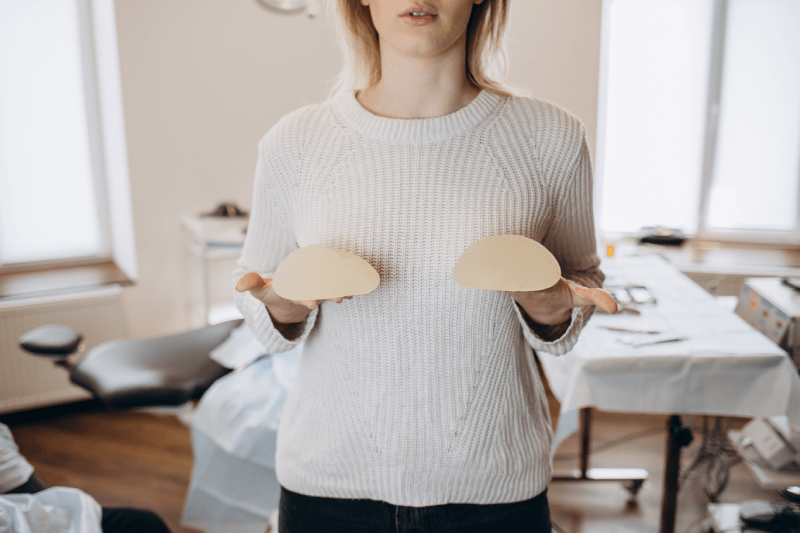What Is Breast Augmentation?
Breast augmentation is a surgical procedure that increases the volume and fullness of the breasts by placing silicone or saline-based materials called breast implants. This operation is preferred by women who are unhappy with the size of their breasts, or who are bothered by the reduction and sagging of their breasts after pregnancy or weight loss.
Why Is It Done?
The main reasons for breast augmentation surgery are:
- Aesthetic Concerns: To help women feel more comfortable with their bodies and boost their self-confidence.
- Balancing Body Proportions: To make body contours more proportionate.
- Congenital Abnormalities: To correct congenital breast asymmetry.
- Changes After Weight Loss or Pregnancy: To restore the lost volume and fullness of the breasts.
What Are the Benefits?
The potential benefits of breast augmentation surgery include:
- Increased Self-Confidence: Many women report feeling more positive about their bodies and more comfortable in their social lives after this operation.
- Better-Fitting Clothes: The improved body proportions help clothes look more aesthetic.
- Psychological Relief: It can eliminate the anxiety and discomfort they experience due to the size of their breasts.
- Improved Body Proportions: It provides a balance between the upper and lower halves of the body, creating a more harmonious silhouette.
What Are the Risks?
As with any surgical procedure, breast augmentation surgery carries certain risks:
- Post-Surgical Complications: General surgical risks such as pain, swelling, bruising, and infection are present.
- Implant Leakage or Rupture: There is a risk of the inner material leaking or the implant rupturing due to wear and tear or impact over time.
- Capsular Contracture: This is a condition where the scar tissue (capsule) that forms around the implant hardens and tightens. This can lead to pain and breast deformity.
- Changes in Nipple Sensation: There may be an increase or decrease in nipple sensitivity after the surgery.
- Anesthesia-Related Risks: Allergic reactions or other complications related to anesthesia may occur.
To minimize these risks, it is important that the operation is performed by an experienced and competent plastic surgeon and that you get detailed information about all risks before the surgery. If you want to learn more about breast augmentation or whether it is suitable for you, you can consult a plastic surgeon.
Who Is a Suitable Candidate for Breast Augmentation Surgery?
Suitable candidates for breast augmentation surgery are generally individuals in good physical and emotional health. This operation offers a solution for women who are dissatisfied with the size of their breasts or have experienced a loss of breast volume due to reasons like pregnancy or weight loss.
Here are the basic characteristics of suitable candidates for breast augmentation surgery:
- Physical Health: Candidates should not have any serious health problems (e.g., heart disease, uncontrolled diabetes) that could pose a risk during the surgery. Smoking must be stopped before the operation, as it negatively affects the healing process.
- Completed Breast Development: The surgery is generally considered appropriate for women aged 18 and older who have completed their breast development.
- Realistic Expectations: It is crucial to have realistic expectations about the results of the surgery and potential risks. A detailed consultation with a plastic surgeon helps to clarify these expectations.
- Psychological Readiness: The decision to undergo surgery should be made based on the individual’s own desire, not influenced by others.
- Special Circumstances:
- Breast Asymmetry: The surgery can be performed to achieve symmetry in cases where one breast is noticeably smaller than the other.
- Poland Syndrome: It can also be considered a surgical solution for congenital breast and chest muscle deformities.
- Post-Breast Cancer: It is also used for reconstruction purposes to restore breast volume in patients who have lost breast tissue due to cancer treatment.

What are the types of implants used in breast augmentation surgery?
Based on Implant Materials
- Silicone Implants: The inside of these implants is filled with silicone gel. Silicone gel is widely preferred because it gives a feel closest to natural breast tissue. Today’s silicone implants contain “cohesive” (sticky) gel that maintains its shape even in the event of a leak.
- Saline (Salt Water) Implants: These implants are balloon-like structures with a silicone outer shell and filled with sterile saline (salt water). They are placed empty during surgery and then filled with saline until the desired volume is reached. They can feel firmer than silicone implants, and in case of a leak, the body absorbs the saline, leading to an immediate loss of volume.
Based on Surface Structure
- Smooth-Surfaced Implants: As the name suggests, these implants have a smooth and slick surface. They can move more easily within the body, which can provide a natural feel. However, in some cases, the risk of capsular contracture (the formation of hard tissue around the implant) may be slightly higher.
- Textured-Surfaced Implants: The surface of these implants is made slightly rough to reduce the risk of capsular contracture. The textured surface allows the implant to adhere better to the surrounding tissues and helps it stay in place.
Based on Shape
- Round Implants: This is the most commonly used implant shape. It adds fullness to the upper part of the breast, making the cleavage area more prominent. It provides uniform fullness to the entire breast.
- Teardrop (Anatomic) Shaped Implants: These implants are, as the name suggests, shaped like a natural breast teardrop. The lower part is fuller, and the upper part is thinner. They are preferred by those who want a more natural look. However, if they rotate, they can cause a distortion in the breast shape.
Should I Place the Breast Implant Under or Over the Muscle?
The placement position of implants used in breast augmentation surgery is evaluated in two main categories: submuscular and subglandular. Both methods have their own unique advantages and disadvantages, and the choice of which method to prefer depends on the individual’s anatomy, the amount of breast tissue, and the surgeon’s experience.
Subglandular Placement
In this technique, the implant is placed directly under the breast gland and on top of the chest muscle (pectoral muscle).
Advantages:
- Faster and easier surgery: The operation time is generally shorter as the muscle tissue is not interfered with.
- Less pain: Post-operative pain is milder because the muscle is not cut or separated.
- Faster recovery: Patients can usually return to their normal lives in a shorter period.
- More natural-looking breast shape: In some cases, it can help the implant stay in a higher position, aiding a more natural position for the nipple.
Disadvantages:
- More noticeable implant: Especially in thin individuals with little breast tissue, the edges of the implant can be felt or seen from the outside.
- Risk of rippling: The risk of a rippling appearance is higher with silicone gel implants.
- Affects breast ultrasound and mammography results: The implant, being under the breast tissue, can obstruct a clear view of the lower part of the breast in these imaging methods.
Submuscular Placement
In this method, the implant is placed under the chest muscle (pectoral muscle). This can mean that part or all of the implant is under the muscle (dual-plane technique).
Advantages:
- More natural look and feel: The muscle tissue covering the implant provides a more natural result, and the edges of the implant are less noticeable.
- Reduced risk of rippling: The muscle layer on top of the implant masks the rippling appearance.
- Reduced risk of capsular contracture (hardening): The constant movement of the muscle can reduce the risk of a hard capsule forming around the implant.
- Better results for mammography and ultrasound: As the implant is behind the breast tissue, the breast tissue can be more easily examined during mammography.
Disadvantages:
- More painful recovery period: Post-operative pain can be more severe due to the stretching and separation of muscle tissue.
- Longer operation time: The surgery time is longer as it is a technically more challenging procedure.
- Slower recovery: It may take a little longer for patients to return to their normal lives compared to subglandular placement.
- Changes in breast shape: In some cases, temporary changes in the shape of the implant (bunching) can be observed with muscle contraction.
Which Method Is Better?
Deciding which method is most suitable for you is possible after a detailed evaluation with your surgeon. Your surgeon will determine the most appropriate option for you by considering factors such as the thickness of your breast tissue, the current size of your breasts, your skin’s elasticity, your body structure, and your lifestyle.
Preparations Before Breast Enlargement Surgery
Preparation for breast enlargement surgery is a critical phase that significantly impacts the success of the procedure and the speed of your recovery. Following your surgeon’s specific instructions is the most important step, but this general guide covers key areas to focus on in the weeks and days leading up to your surgery.
Medical and Lifestyle Preparations
This category focuses on steps you need to take to optimize your health and minimize surgical risks.
- Consultation and Medical Clearance: In the months leading up to the surgery, you will have multiple consultations with your plastic surgeon. This is a time to discuss your goals, select the implant type and size, and plan the incision location. Your surgeon will also order pre-operative tests, which may include blood work, a mammogram, or an EKG, to ensure you are in good health.
- Stop Smoking: Nicotine use is a major risk factor for poor wound healing and can lead to complications. It is essential to stop smoking for at least four to six weeks before your surgery and continue to abstain for several weeks afterward to promote proper recovery.
- Manage Medications and Supplements: Your surgeon will provide a specific list of medications and supplements to avoid. Generally, you will be instructed to stop taking aspirin, ibuprofen, certain anti-inflammatory drugs, and some herbal supplements (like vitamin E, fish oil, and green tea) a few weeks before the procedure, as they can increase the risk of bleeding. Always consult your surgeon before making any changes to your regular medications.
- Alcohol and Diet: Reduce your alcohol intake in the weeks leading up to surgery, as alcohol can also thin the blood. Maintain a healthy, balanced diet rich in protein, vitamins, and minerals to support your body’s healing process.
Practical Preparations
These are the logistical and at-home steps you can take to make your recovery as comfortable as possible.
- Plan Your Recovery: Arrange for at least a week off from work or school. You will need a responsible adult to drive you home after the surgery and to stay with you for at least the first 24 hours.
- Set Up Your Recovery Area: Create a comfortable and easily accessible “nest” where you can rest. This area should have plenty of pillows to keep your upper body elevated, as you will need to sleep on your back for the first few weeks. Make sure you have easy access to your phone, charger, remote control, and any books or entertainment.
- Prepare Your Wardrobe: Your arms will have limited mobility after surgery. Pack loose-fitting, comfortable clothing that buttons or zips up the front, as well as slip-on shoes. Avoid anything you have to pull over your head.
- Stock Up on Supplies: Before surgery, fill any prescriptions for pain medication and antibiotics. Stock your pantry with easy-to-prepare meals and snacks. You may also want to have a thermometer, ice packs, and moist towelettes for convenience.
The Day Before and Day of Surgery
- Follow Fasting Instructions: You will receive strict instructions on when to stop eating and drinking, usually after midnight the night before. Following these instructions is crucial for your safety under anesthesia.
- Shower and Cleanse: Take a thorough shower the night before or the morning of the surgery using an antibacterial soap if recommended by your surgeon. Do not apply any deodorant, lotions, perfumes, makeup, or nail polish.Wear Appropriate Clothing: On the day of your surgery, wear the loose, comfortable clothing you prepared. Leave all jewelry, body piercings, and contact lenses at home.
Post-Operative Recovery Process and Things to Consider
Surgery is a process where the body experiences significant trauma, and recovery is a critical stage to overcome this trauma. The recovery process varies depending on the type of surgery, the patient’s general health, and the care provided after the operation. Here are the most important points to consider during this process:
Rest and Sleep
The most important rule after surgery is to allow your body enough time to rest. Adequate sleep is vital for the body to repair itself and strengthen the immune system.
- First Few Days: Rest as much as possible immediately after the surgery. If possible, take care not to get out of bed for the first few days.
- Sleep Schedule: Establish a regular sleep schedule to support your body’s natural healing rhythm.
Pain Management
Pain is a natural part of the recovery process. Regularly using the pain medication prescribed by your doctor will both increase your comfort and make it easier for you to move.
- Medication Tracking: Take pain medication according to your doctor’s instructions. Taking your medication on time prevents the pain from intensifying.
- Pain Scale: Rate your pain on a scale from 1 to 10 to give your doctor or nurse accurate information about your condition.
Nutrition
A balanced and protein-rich diet is very important for recovery. Your body gets the building blocks it needs for repair from nutrients.
- Protein: Consume protein sources such as meat, fish, chicken, eggs, and legumes.
- Fiber: Eat fibrous foods, including vegetables, fruits, and whole-grain products, to prevent constipation. Post-surgery constipation can cause discomfort in the abdominal area and pressure on the wound site.
- Fluid Intake: Drink plenty of water to ensure hydration and support the recovery process.
Movement and Exercise
With your doctor’s approval, starting gentle movements increases blood circulation and reduces the risk of blood clot formation.
- First Steps: Move your legs and feet while in bed.
- Short Walks: Depending on the type of surgery, start taking short, slow walks. Walks help you regain muscle strength.
- Doctor’s Approval: Before starting physical activities, be sure to consult your doctor and follow the exercises they recommend.
Wound Care
Maximum attention should be paid to wound care to prevent the surgical area from getting infected.
- Cleanliness: Keep the wound area dry and clean. Change your dressing as recommended by your doctor.
- Observation: Regularly check the wound site for signs of infection such as redness, swelling, increased warmth, bad odor, or purulent discharge. If you notice any of these signs, contact your doctor immediately.
Emotional Support
The post-surgery period can be challenging, both physically and emotionally.
- Socializing: Spend time with your family and friends, and share your feelings with them.
- Professional Help: If you feel anxiety, depression, or demoralized, consider seeking support from a psychologist.
Post-surgery recovery is a process that requires patience and discipline. By following the steps in this guide and adhering to your doctor’s instructions, you can recover more quickly and healthily.
Why is Breast Augmentation Surgery So Popular in Turkey?
In recent years, Turkey has become a prominent hub in the field of aesthetic and plastic surgery. One of the most significant indicators of this popularity is the increasing number of breast augmentation surgeries. There are several reasons behind this trend.
Affordable Prices
The costs of aesthetic surgeries in Turkey are considerably lower compared to Western European and North American countries. This creates a significant appeal for patients coming from abroad. The price-quality balance plays a critical role in many patients choosing Turkey. In addition to surgery costs, extra expenses like accommodation and transportation are also more economical than in other countries.
High-Quality Services and Experienced Surgeons
Despite the low prices, the quality of aesthetic surgery services in Turkey is very high. Medical faculties and hospitals in the country provide education and services at international standards. Turkish aesthetic surgeons, thanks to their education both domestically and abroad and their commitment to staying up-to-date, have a vast wealth of knowledge in this field. Furthermore, the medical equipment and implants used are in line with the latest technology.
Health Tourism Policies
The Turkish government actively promotes health tourism. Within this scope, special packages and conveniences are offered for many medical procedures, including aesthetic surgeries. Clinics and hospitals supervised by the Ministry of Health have the necessary certifications for international patients to come with confidence. These supportive policies have contributed to the rapid growth of the sector.
Geographical Location and Easy Access
Turkey’s strategic location offers easy access for patients from both European and Middle Eastern countries. Airports in major cities like Istanbul and Ankara are hubs for international flights. This makes patients’ travels less tiring and more practical.
Social and Cultural Factors
Today’s social media and digital platforms are constantly transforming perceptions of beauty and aesthetics. There is also an increasing aesthetic awareness in Turkey. The desire to have a better appearance has become widespread, especially among the younger population. This situation increases the demand for aesthetic surgeries like breast augmentation.

Why Are Surgery Prices in Turkey More Affordable?
Turkey has become a prominent destination in medical tourism, offering more affordable surgery prices compared to Western countries for the same high-quality healthcare services. This is due to a combination of economic and structural factors.
Lower Overhead and Labor Costs
One of the most significant reasons for the affordability of surgery in Turkey is the lower general operating costs, such as labor, energy, rent, and administrative expenses, compared to other countries. These cost items, including the salaries of healthcare professionals (surgeons, nurses, and other medical staff), are reflected in the service prices.
Favorable Exchange Rate
The value of the Turkish Lira against other strong currencies (Euro, Dollar, Pound Sterling) makes healthcare services in Turkey highly attractive to international patients. When a foreign patient pays in their own currency, they can receive the same quality of service at a much more affordable price compared to their home country. This creates a direct advantage stemming from the exchange rate difference.
High Competition and Volume
There are numerous hospitals and clinics operated by both the state and the private sector in Turkey. This highly competitive environment encourages healthcare providers to keep their prices competitive. Furthermore, the high volume of medical tourists helps reduce the cost per unit, allowing surgery prices to remain at more affordable levels.
Government Incentives and Investments
The Turkish government views health tourism as a strategic sector and supports its growth. Large-scale investments in modern healthcare infrastructure have led to the widespread use of the latest medical devices and equipment. These investments and incentives help improve quality while keeping costs under control.
Package Pricing
Many Turkish hospitals and clinics offer all-inclusive packages that include not only surgery prices but also services like accommodation, transfers, and even city tours. These packages enable patients to know their costs in advance, making budget planning easier and eliminating hidden costs.
Reliability of Breast Augmentation Surgery in Turkey
Surgeon’s Competence and Experience
One of the most important factors for the reliability of the surgery is the competence and experience of the plastic surgeon who will perform the operation. To understand a surgeon’s reliability, you can pay attention to the following:
- Area of Expertise: Make sure you consult a plastic, reconstructive, and aesthetic surgeon who specializes in breast augmentation surgery.
- Certifications: The surgeon’s memberships in relevant professional associations (for example, the Turkish Society of Plastic, Reconstructive and Aesthetic Surgeons – TPCD) and international certifications can be an indicator of their training and competence.
- Experience: The length of time and frequency the surgeon has performed such operations, as well as feedback on their success rate and patient satisfaction, are important.
Quality of the Implant Used
The quality of the silicone implants used in breast augmentation surgery also directly affects reliability. For a reliable surgery, products from well-known and trusted brands with international standards such as FDA (U.S. Food and Drug Administration) or CE (European Conformity) approval should be preferred. These implants are designed to minimize the risk of rupture or leakage and offer safe, long-term use.
Hospital and Conditions Where the Surgery is Performed
The conditions of the hospital or surgical center where the surgery is performed are also of great importance.
- Equipment: The hospital should have a fully equipped operating room and intensive care unit to handle possible complications.
- Hygiene: A sterile and hygienic operating room environment minimizes the risk of infection.
- Staff: In addition to the surgeon, the anesthesiologist and other healthcare personnel should also be experienced and competent.
Accurate Information and Communication
A reliable surgeon will transparently explain all possible risks, how the surgery will be performed, the recovery process, and possible complications before the operation. They will evaluate whether your expectations are realistic and guide you correctly.
Many aesthetic surgeons in Turkey provide services at international standards, and breast augmentation surgeries are performed very commonly and successfully. However, choosing the right surgeon and hospital is crucial for the reliability of this process.
When considering surgery, I recommend meeting with a few different surgeons to find the one that suits you best. Do not hesitate to ask each surgeon about their experience, the implants they use, and the hospital conditions where the surgery will be performed.
Tips for Choosing the Right Surgeon and Clinic in Turkey
Choosing the right surgeon and clinic in Turkey is critically important for a successful surgical process and satisfying results. Here are some tips to consider when making this important decision:
Surgeon’s Experience and Expertise
Research how experienced the surgeon is in the specific type of surgery you are considering. Focus not only on how many years the surgeon has been practicing but also on how frequently and how many times they have performed that specific procedure. For example, a plastic surgeon specializing in rhinoplasty is more important than just having a general surgery diploma.
- Certifications and Memberships: Check if the surgeon is a member of relevant professional organizations (for example, the Turkish Society of Plastic, Reconstructive and Aesthetic Surgeons) and if they hold certifications from these organizations.
- Previous Patient Results: If possible, ask to see photos of the surgeon’s previous surgeries (before and after). This will help you understand the surgeon’s aesthetic sense and skill.
Quality of the Clinic or Hospital
The place where the surgery will be performed is very important for both safety and comfort.
- Accreditation: Make sure the clinic or hospital has accreditation documents showing its compliance with the standards set by the Ministry of Health.
- Technology and Equipment: Inquire whether modern medical devices and technology are used to enhance the success and safety of the surgery.
- Staff: The clinic should have experienced and sufficient nurses and health personnel to support you before, during, and after the surgery.
Communication and Trust
The communication you establish with your surgeon is vital for you to feel comfortable throughout the entire process.
- Open Communication: Your surgeon should be able to communicate with you in a clear and understandable manner and be able to honestly discuss your expectations and potential risks. You should feel comfortable asking any questions you have.
- Realistic Expectations: Your surgeon should provide you with realistic information about the potential outcomes of the surgery and avoid promising miraculous results.
Transparent Pricing
Get clear and transparent information about the cost of the surgery. Find out what is included in the price (surgeon’s fee, anesthesia, hospital stay, medications, follow-up appointments, etc.). Make sure there are no hidden costs.
Patient Reviews and References
The experiences of other patients can give you important insights about the surgeon and the clinic.
- Online Reviews: Look at patient reviews on online forums, social media groups, or the clinics’ own websites. However, keep in mind that these reviews may not always be 100% accurate.
- Requesting References: You can ask your surgeon for references from patients they have previously operated on.
Follow-up and Check-ups After Breast Augmentation Surgery in Turkey
Post-operative care and follow-ups after a breast augmentation surgery in Turkey are of great importance for the success of the operation and for patient safety. The post-operative process usually progresses according to a schedule determined by your surgeon. These follow-ups and check-ups help with the early diagnosis of possible complications and the proper management of the recovery process.
Initial Post-operative Check-ups
Immediately after the surgery, typically within the first 24 to 48 hours, your dressing will be changed and your general condition will be checked by your surgeon. This initial check-up is important to evaluate for any abnormal bleeding or swelling. At this stage, your doctor may prescribe painkillers and antibiotics and will give you information on how to use them.
First Week and Subsequent Follow-ups
Within the first week after the surgery, a follow-up is usually performed one or two more times, typically on the 5th and 7th days. During these check-ups, the following are evaluated:
- Stitch Condition: The healing of your stitches and wound sites is examined.
- Edema and Swelling: The reduction of swelling and bruising in the surgical area is monitored.
- Implant Position: It is checked whether the breast implants are in the correct position.
During this process, your surgeon may advise you to wear a special bra, avoid heavy lifting, and refrain from certain exercises. Adhering to these instructions is critical for a successful recovery.
Long-Term Follow-ups and Check-ups
Regular check-ups continue at the end of the first month and in subsequent months. These follow-ups generally include:
- 1-Month Check-up: Since a large part of the healing process is complete, the final shape and symmetry of the breasts are evaluated.
- 3-Month and 6-Month Check-ups: The placement of the implants and the final appearance of the breasts are monitored during this period. Check-ups are done for potential long-term complications like capsular contracture.
- Annual Check-ups: After the first year, regular check-ups are generally recommended on an annual basis. These check-ups are important for evaluating the health of the implants and your overall breast health.
During these annual check-ups, your surgeon may examine your breasts and may request additional imaging methods such as breast ultrasound or mammography if necessary. This is important for checking both the condition of the implants and your general breast health.
What to Pay Attention to During the Follow-up Process
- Keep Your Appointments: Make sure to attend all follow-up appointments set by your surgeon.
- Ask Your Questions: Do not hesitate to ask your doctor about anything that comes to your mind regarding your recovery process.
- Contact in Case of Abnormalities: Contact your surgeon immediately if you experience unusual situations such as fever, severe pain, excessive swelling, or discharge from the wound site.
Remember, post-operative care and follow-ups after a breast augmentation surgery not only preserve the successful results of the operation but also ensure that you have a healthy and safe process in the long term. Therefore, it is of great importance to follow all of your surgeon’s recommendations.

Pre- and Post-Operative Accommodation Options in Turkey
If you’re having surgery in Turkey or have a relative who is, finding accommodation for the pre- and post-operative period is very important. There are various accommodation options available that can support your comfort and recovery during this process.
Hotels Next to and Around the Hospital
Many private hospitals have their own affiliated hotel services or have agreements with hotels nearby. These hotels are usually located in a spot easily accessible for patients and their companions. Staying close to the hospital before surgery reduces the stress of getting there on time and makes it easier to attend necessary check-ups. After surgery, being close to the hospital is a great advantage for check-ups and bandage changes once you’ve been discharged. Since these hotels cooperate with the hospitals, some may offer special discounts or additional services.
Hospital Accommodation Services
Especially for cosmetic surgeries or those requiring longer-term treatment, some hospitals offer accommodation services as part of the surgery package. This service may be in the hospital’s own inpatient wards or in special accommodation units belonging to the hospital. This type of accommodation ensures you are under full medical supervision and is a safer option for sudden situations. This option usually comes into play when you need to stay in the hospital for a night or a few days after the surgery.
Rental Apartments Near the Hospital
For those planning a longer stay or who prefer the comfort of a home instead of a hospital environment, daily or weekly rental apartments can be an ideal option. These apartments are often more economical and offer a larger space compared to hotels, especially for larger families. They also provide the opportunity to cook your own meals or rest in a more comfortable setting during the recovery process. When searching for a rental apartment, it’s important to pay attention to its distance from the hospital and ease of transport. Booking through reliable platforms and reading reviews from previous guests can reduce the risk of encountering unpleasant surprises.
Things to Consider When Choosing Accommodation
- Distance: The distance of the accommodation from the hospital is very important to reduce your fatigue during the pre- and post-operative period. It will be helpful to choose a place that is within walking distance or a short taxi ride away.
- Transport: Check the public transport options, taxi stands, or parking facilities.
- Comfort and Hygiene: Being in a comfortable and hygienic environment during the recovery process is critical for your morale and health. Be sure to check the cleanliness standards and the amenities provided (e.g., elevator, disabled access).
- Additional Services: Some hotels or accommodations may offer rooms specially designed for patients or medical support services. Asking about these additional services can influence your decision.


